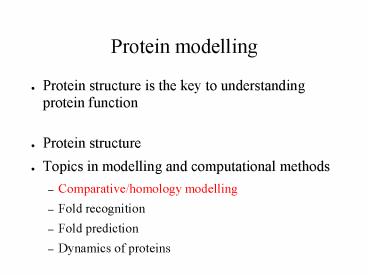Protein modelling - PowerPoint PPT Presentation
1 / 38
Title:
Protein modelling
Description:
Protein structure determines ... Chothia & Lesk (1986): Correlation between structural divergence and ... Fold prediction Rosetta method. Knowledge based ... – PowerPoint PPT presentation
Number of Views:83
Avg rating:3.0/5.0
Title: Protein modelling
1
Protein modelling
- Protein structure is the key to understanding
protein function - Protein structure
- Topics in modelling and computational methods
- Comparative/homology modelling
- Fold recognition
- Fold prediction
- Dynamics of proteins
2
Motivation
- Protein structure determines protein function
- For the majority of proteins the structure is not
known
3
(No Transcript)
4
(No Transcript)
5
(No Transcript)
6
Steps in comparative modelling
- Find suitable template(s)
- Build alignment between target and template(s)
- Build model(s)
- Replace sidechains
- Resolve conflicts in the structure
- Model loops (regions without an alignment)
- Evaluate and select model(s)
7
State of the art in homology modelling
- Template search
- (iterative) sequence database searches (PSIBLAST)
- Alignment step
- multiple alignment of close to fairly distant
homologues - Modelling step
- rigid body assembly
- segment matching
- satisfaction of spatial constraints
8
Modelling by spatial restraints
- Generate many constraints
- Homology derived constraints
- Distances and angles between aligned positions
should be similar - Stereochemical constraints
- Bond lengths, bond angles, dihedral angles,
nonbonded atom-atom contacts - Model derived by minimizing restraints
Modeller Sali Blundell (1993)
9
Loop modelling
- Exposed loop regions usually more variable than
protein core - Often very important for protein function
- Loops longer than 5 residues difficult to built
- Mini-protein folding problem
10
Model evaluation
- Check of stereochemistry
- bond lengths angles, peptide bond planarity,
side-chain ring planarity, chirality, torsion
angles, clashes - Check of spatial features
- hydrophobic core, solvent accessibility,
distribution of charged groups,
atom-atom-distances, atomic volumes, main-chain
hydrogen bonding - 3D profiles/mean force potentials
- residue environment
11
Knowledge-based mean force potentials
- Compute typical atomic/residue environments based
on known protein structures
Melo Feytmanns (1997)
12
Modelling a transcription factor
- Sequence from different species
- Is binding to ligand conserved?
13
Ligand binding domain
hydrogen bonds to ligand
homo-serine lactone moiety binding
acyl moiety binding
14
DNA binding domain
DNA binding domain
Linker
15
New Loop
Template
Target
Variable loops
MODELLER output
16
Ligand binding pocket
17
Errors in comparative modelling
- Side chain packing
- Distortions and shifts
- Loops
- Misalignments
- Incorrect template
True structure
Template
Model
Marti-Renom et al. (2000)
18
Modelling accuracy
Marti-Renom et al. (2000)
19
Applications of homology modelling
Marti-Renom et al. (2000)
20
Structural genomics
- Post-genomics
- many new sequences, no function
- Aim a structure for every protein
- High-throughput structure determination
- robotics
- standard protocols for cloning/expression/crystall
ization
21
Structural coverage
high quality models
Complete models
Total 43
Vitkup et al. (2001)
22
Target selection
23
Protein modelling
- Protein structure is the key to understanding
protein function - Protein structure
- Topics in modelling and computational methods
- Comparative/homology modelling
- Fold recognition
- Fold prediction
- Dynamics of proteins
24
Fold recognition
- Structure is more conserved than sequence
Limit of sequence similarity searches
Structural similarity
Target
Protein structures
Fold space
25
Fold recognition / Threading
- Is a sequence compatible with a structure?
- The idea evolutionary related proteins share
common folding motifs - Contact matrix motif
- Mean-force potentials to score every contact
- Optimize alignment to minimize pseudo-energy
26
Protein modelling
- Protein structure is the key to understanding
protein function - Protein structure
- Topics in modelling and computational methods
- Comparative/homology modelling
- Fold recognition
- Fold prediction
- Dynamics of proteins
27
(No Transcript)
28
(No Transcript)
29
(No Transcript)
30
(No Transcript)
31
Results
- Small molecules ok
- Proteins with mostly a-helices ok
- Proteins with mostly ß-sheets not so ok
Simons et al. (1997)
32
Dynamics of proteins
- Protein structure is the key to understanding
protein function - Protein structure
- Topics in modelling and computational methods
- Comparative/homology modelling
- Fold recognition
- Fold prediction
- Dynamics of proteins
33
Dynamics of proteins
- Local Motions (0.01 to 5 Å, 10-15 to 10-1 s)
- Atomic fluctuations
- Sidechain Motions
- Loop Motions
- Rigid Body Motions (1 to 10Å, 10-9 to 1s)
- Helix Motions
- Domain Motions (hinge bending)
- Subunit motions
- Large-Scale Motions (gt 5Å, 10-7 to 104 s)
- Helix coil transitions
- Dissociation/Association
- Folding and Unfolding
34
Molecular dynamics/molecular modelling
- Molecular mechanics
- Normal mode analysis
- Quantum mechanical simulations
- ...
35
Molecular mechanics
- Atom representation
- sphere
- charge
- topology
- Forces
- Bonded interactions
- Non-bonded interactions
- Electrostatic interactions
- Van-der-Waals interactions
- Forcefields AMBER, GROMOS, ...
- Newton's law of mechanics
http//cmm.info.nih.gov/modeling/guide_documents/m
olecular_mechanics_document.html
36
Molecular mechanics
- Molecular mechanics simulations take long!
- because of the size of the system
- Proteins are large
- Water molecules to consider solvent effects
- 10.000 to millions of atoms
- because of the number of iterations
- update atom positions according to time-scale of
fastest fluctuations bond vibrations ca. 1 fs - movements of interest frequently have long
time-scale,e.g. folding - 1s gt 1015 iterations!
37
Benefit of simulations
- Result is an ensemble of structures
- Time-averaged statistical quantities
- e.g., relative free energies of different
conformations - Protein engineering
- e.g., relative free energies of different mutants
- Physical accuracy of models?
- chemical reactions?
- cutoff and long-range interactions?
- dielectric constant?
movie from C. Letner, G. Alter Journal of
Molecular Structure (Theochem) 368 (1996) 205212
38
The end
- Proteins are beautiful!
www.holmgroup.org































